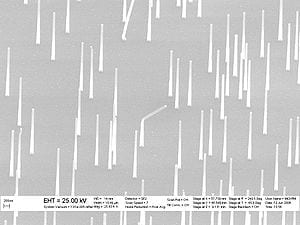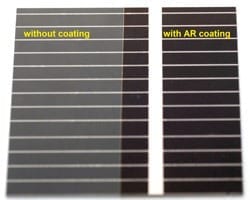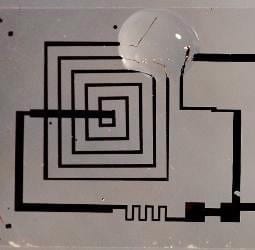
Imagine a solar panel more efficient than today’s best solar panels, but using 10,000 times less material.
This is what EPFL researchers expect given recent findings on these tiny filaments called nanowires. Solar technology integrating nanowires could capture large quantities of light and produce energy with incredible efficiency at a much lower cost. This technology is possibly the future for powering microchips and the basis for a new generation of solar panels.
Despite their size, nanowires have tremendous potential for energy production. “These nanowires capture much more light than expected,” says Anna Fontcuberta i Morral about her research, published on March 24 in Nature Photonics.
Nanowires are extremely tiny filaments–in this case able to capture light–with a diameter that measures tens to hundreds of nanometers, where a nanometer is one millionth of a millimeter. These miniscule wires are up to 1000 times smaller than the diameter of human hair, or comparable in diameter to the size of viruses.
When equipped with the right electronic properties, the nanowire becomes a tiny solar cell, transforming sunlight into electric current. Anna Fontcuberta i Morral and her team built a nanowire solar cell out of gallium arsenide, a material which is better at converting light into power than silicon. They found that it actually collects more light than the usual flat solar cell–up to 12 times more–and more light means more energy.
The nanowire standing vertically essentially acts like a very efficient light funnel. Even though the nanowire is only a few hundred nanometers in diameter, it absorbs light as though it were 12 times bigger. In other words, it has a greater field of vision than expected.
Fontcuberta’s prototype is already almost 10% more efficient at transforming light into power than allowed, in theory, for conventional single material solar panels. Furthermore, optimizing the dimensions of the nanowire, improving the quality of the gallium arsenide and using better electrical contacts to extract the current could increase the prototype’s efficiency.
The Latest Bing News on:
Nanowires
- Scripps Research professor emeritus John Johnson selected as member of the National Academy of Scienceson May 11, 2024 at 7:21 am
Scripps Research professor emeritus John Johnson, PhD, has been elected to the National Academy of Sciences—one of the highest honors given to scientists.
- Soft caterpillar robot moves its body by origami-poweron May 9, 2024 at 2:49 pm
If a soft-bodied robot uses rigid actuators to move its body, then it isn't really soft now, is it? An experimental new caterpillar-inspired bot gets around that conundrum by using soft, collapsible ...
- Photoactive Nanowires Drive Efficient CO2 Conversion in New Photocatalyston May 8, 2024 at 6:11 am
Researchers from Shanghai Jiao Tong developed a new photocatalyst that uses concentrated sunlight to convert methane waste gas and CO2 into syngas, a valuable fuel precursor.
- A photocatalyst for sustainable syngas production from greenhouse gaseson May 7, 2024 at 1:38 pm
Researchers have developed a novel photocatalyst, named Rh/InGaN1-xOx, which is a nanoarchitecture consisting of rhodium nanoparticles anchored on oxygen-modified indium gallium nitride nanowires ...
- Breaking the Scaling Limits: New Ultralow-noise Superconducting Camera for Exoplanet Searcheson May 7, 2024 at 9:18 am
When imaging faint objects such as distant stars or exoplanets, capturing every last bit of light is crucial to get the most out of a scientific mission. These cameras must be extremely low-noise, and ...
- Scientists make electricity from air moisture using bacterial nanowireson May 6, 2024 at 3:51 am
Bacterial nanowires can conduct electricity and can potentially be used to devise sensing systems. However, after being harvested from bacteria, these nanowires are hard to modify and, therefore, have ...
- Discovery of Bacteria ‘Nanowires’ Offers Potential for Green Electronics Developmenton May 5, 2024 at 9:02 pm
Filaments engineered by scientists at UNSW Sydney were shown to produce electricity from moisture in the air.Engineered protein filaments originally produced by bacteria have been modified by ...
- Bacteria 'nanowires' could help develop green electronicson April 29, 2024 at 7:30 am
Engineered protein filaments originally produced by bacteria have been modified by scientists to conduct electricity. In a study published recently in the journal Small, researchers revealed that ...
- Bacteria 'nanowires' could help develop green electronicson April 28, 2024 at 5:00 pm
In a study published recently in the journal Small ("Fabrication of Electronically Conductive Protein-Heme Nanowires for Power Harvesting"), researchers revealed that protein nanowires – which were ...
- Bacterial nanowires make an electrical grid in the soilon April 10, 2024 at 5:00 pm
Wired in: A single protein family acts like a series of electrically connecting "plugs" for charging microbial nanowires. (Courtesy: Eric Martz) Because there’s not much oxygen deep underground, the ...
The Latest Google Headlines on:
Nanowires
[google_news title=”” keyword=”nanowires” num_posts=”10″ blurb_length=”0″ show_thumb=”left”] [/vc_column_text]The Latest Bing News on:
Nanowire solar cells
- Photos: Solar flare makes aurora borealis visible across the globeon May 11, 2024 at 6:32 am
A massive solar storm hit the United States and the rest of the globe Friday evening, becoming the biggest in decades. The intensity of the solar storm painted the night skies in different colors ...
- Power Up Anywhere With These Solar Chargerson May 11, 2024 at 6:03 am
Pack a solar charger for the trip and suddenly you’ve got the world back at your fingertips. These portable gadgets marry solar panels with battery packs—they’re small and lightweight enough to not ...
- Scientists make advancements with groundbreaking binary organic solar cell technology: 'Highly efficient and stable'on May 10, 2024 at 3:15 am
The scientists are improving the technology while also making the cells easier to place. Scientists make advancements with groundbreaking binary organic solar cell technology: 'Highly efficient and ...
- Best Solar Panels For Homes Of 2024on May 9, 2024 at 12:46 pm
Commissions do not affect our editors' opinions or evaluations. Solar panels and their accessories unlock the boundless energy from sunshine and transform it into useful energy at home.
- A low-energy process for high-performance solar cells could simplify the manufacturing processon May 8, 2024 at 7:39 am
Finding reliable, eco-friendly power sources is crucial as our world grapples with increasing energy needs and the urgent call to combat climate change. Solar energy offers one solution, with ...
- Best Solar Panels of May 2024on May 1, 2024 at 5:59 am
Some of her bylines can be found on sites like Business Insider and Shape. In today’s changing world, solar panels have gone from a niche home item to an everyday sight in most American cities.
- The Rise In Solar Waste Is Only Half The Truthon April 29, 2024 at 3:30 am
The other half of the truth concerns solar panel waste management which brings us to the question: How will we manage this considerable waste?
- Switching to solar? We explain three main types of solar panelson April 13, 2024 at 1:31 pm
This commission does not influence our editors’ opinions or evaluations. Monocrystalline residential solar panels are the most common type and are more efficient than polycrystalline panels.
- Alireza Abrandon March 12, 2024 at 6:45 am
His research focused on device fabrication as well as electrical and optical characterization of flexible InP nanowire-based photovoltaic solar cells. During the same period, Alireza worked as a ...
- Wenyong Wangon November 12, 2023 at 2:00 pm
Dr. Wang's research group focuses on the synthesis of binary and ternary metal oxides nanowires, fabrication of nanowire-based solar cells, and investigation of charge generation, transport, and ...
The Latest Google Headlines on:
Nanowire solar cells
[google_news title=”” keyword=”nanowire solar cells” num_posts=”10″ blurb_length=”0″ show_thumb=”left”]










